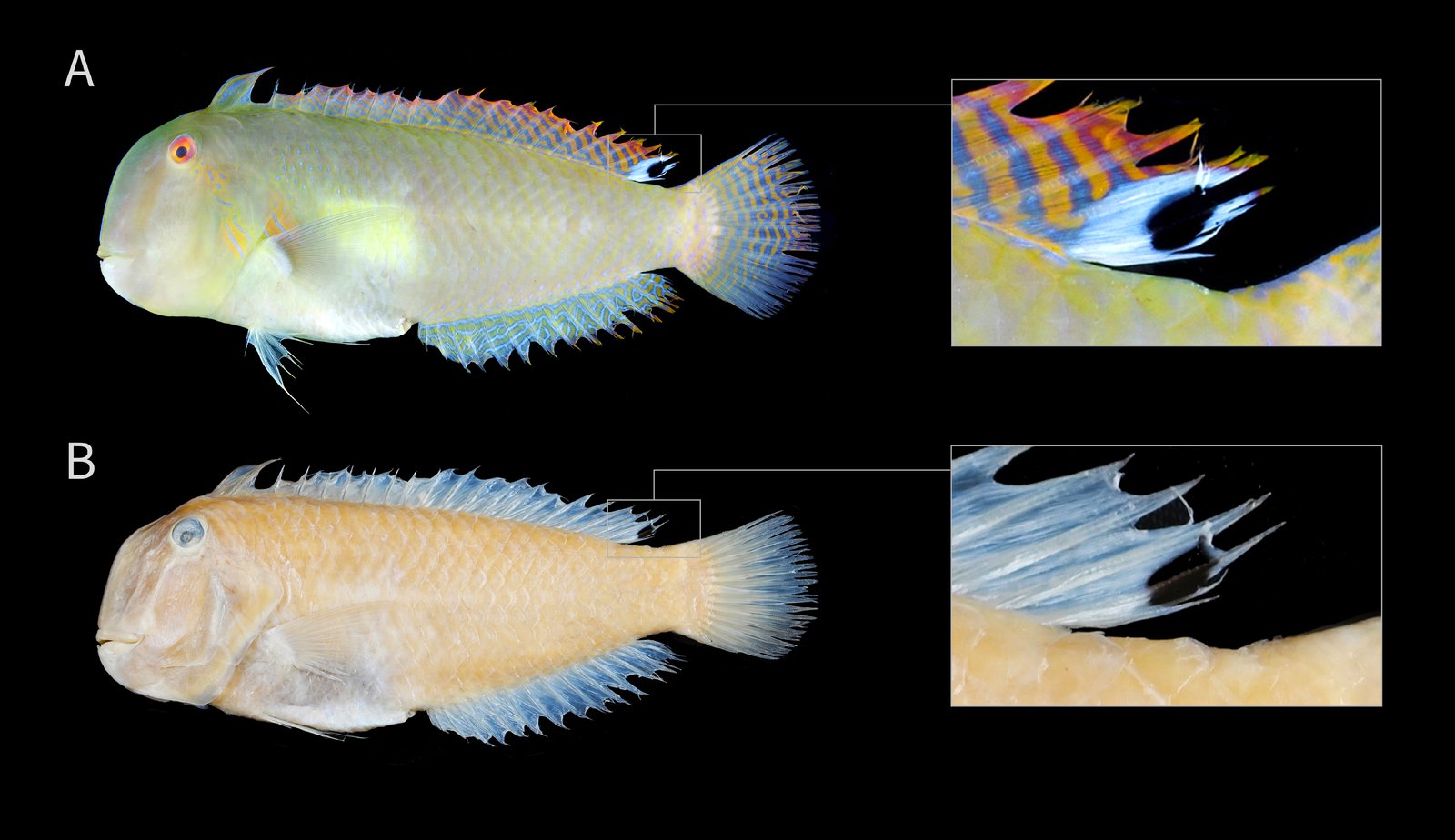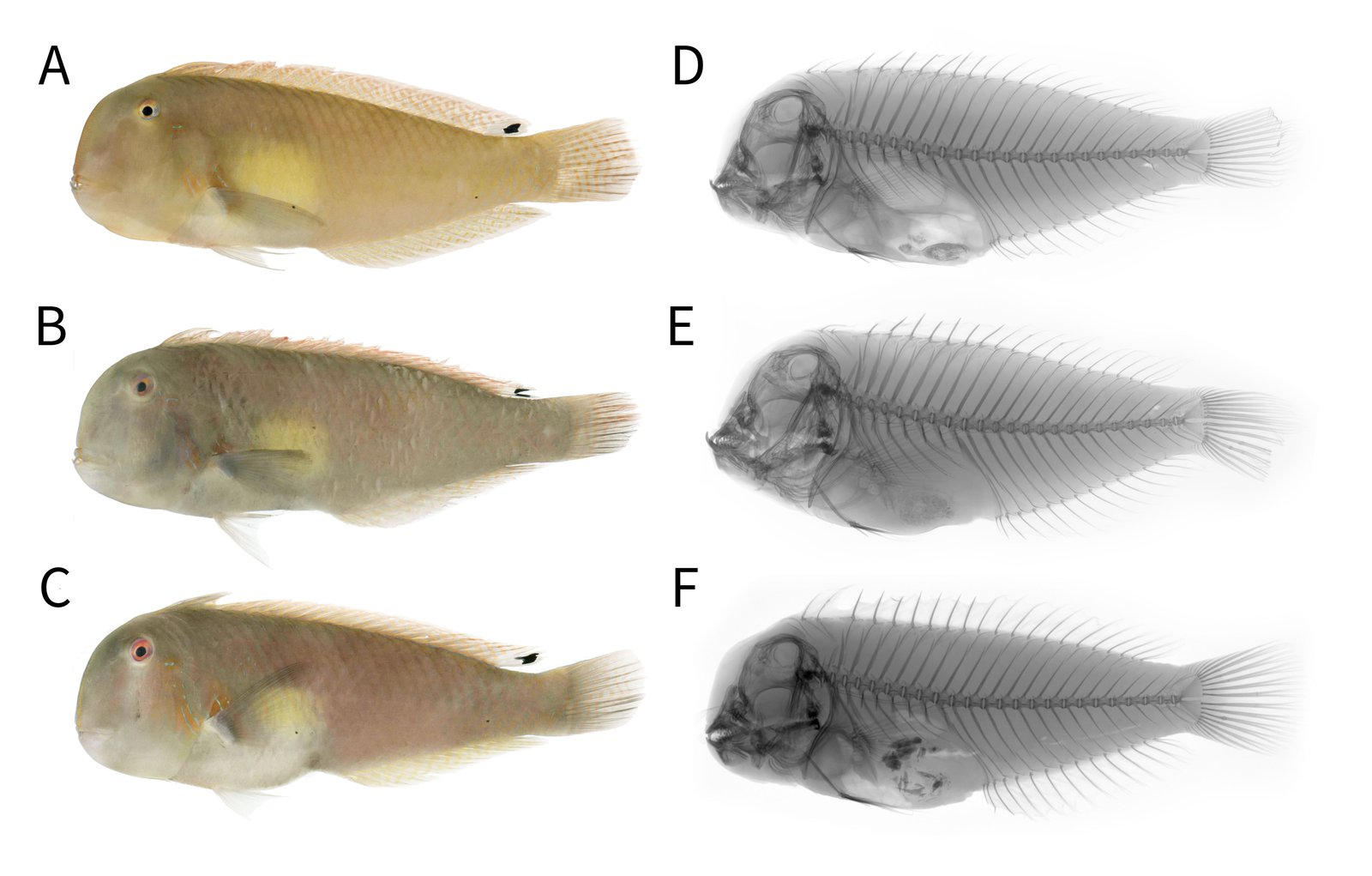The fish that devoured the moon
Public wet markets and trawl surveys unveil a new species of razor wrasse from the Philippines and Western Australia, adding to a group of fishes that live curious lives away from the megadiverse coral reefs.

© Image adapted from Sorgon et al. (2023).
The discovery and description of species new to science often conjure imagery of exhilarating expeditions of scientists in the middle of the tropical rainforests or underwater exploring vibrant coral reefs or the deep abyss. But sometimes, the quiet halls of museum collections and the loud hustle and bustle of wet markets may yield new species hiding in plain sight. A study led by the Australian Museum’s Chadwick Biodiversity Research Fellow Dr Yi-Kai Tea and Kent Elson Sorgon of the University of the Philippines Los Baños, along with colleagues from the Philippines National Museum, describes a new species of razor wrasse (genus Iniistius) collected from public markets in the Philippines and trawl specimens from Western Australia.

© Image adapted from Sorgon et al. (2023).
The new species, Iniistius bakunawa (Eclipse-spot Razor Wrasse), resembles other members of the genus in coloration, but differ in having a pale yellowish to jade green body and a white oval spot with a black central spot on the rearmost edge of its dorsal fin. Iniistius bakunawa is named after the Bakunawa (baa·koo·naa·waa), a serpentine figure in Visayan mythology in the Philippines believed to be responsible for causing eclipses by devouring the moon or the sun. The common name is given after the white-margined black spot, which is reminiscent of what a total solar eclipse would look like. The white margin disappears when the species is preserved in alcohol for a long time, alluding to the ephemeral nature of eclipses.

© Image adapted from Sorgon et al. (2023).
Unlike their coral reef-associated relatives, razor wrasses live almost exclusively in wide sandy habitats. Since these habitats are often overlooked by divers, the biology and taxonomy of razor wrasses are poorly known. Consequently, representation of these fishes in museum collections are similarly depauperate. Kai and colleagues described the new species based on only nine specimens deposited in museums in the Philippines, the United States, Japan, and Australia. The holotype sits in the National Museum of Natural History of the National Museum of the Philippines. Three paratypes are housed in Australian museums; one at the Australian Museum and two in the CSIRO Australian National Fish Collection, Hobart. The description of the new species is accompanied by a brief discussion on the status of the genus Iniistius. When some characteristics for distinguishing Iniistius from other related wrasses were revisited (i.e., the presence of cheek scales and a notch on the front of their dorsal fin), these were found to be inconsistent throughout the genus. The genus, and perhaps its relatives as well, are in need of a formal reappraisal to better understand how these wrasse species are related to one another.

© Image adapted from Sorgon et al. (2023).
New species continue to be described annually, some from colourful adventures, others from unexpected places like a public market on a humid noon in April. Much remains to be explored about these wrasses and other fishes that live in seemingly barren areas like sandy habitats. Their presence in wet markets speaks to the diversity of fisheries in the Coral Triangle, which makes “basic” research such as taxonomy even more important to better understand how we can manage our natural resources. All in all, we are still gnawing at the surface of the astounding diversity of fishes, and a species completely new to science might be on your dinner plate right now.
Kent Elson Sorgon, MSc, University of the Philippines Los Baños.
Dr Yi-Kai Tea, Chadwick Biodiversity Research Fellow, Ichthyology, Australian Museum.
More information:
Sorgon, K.E.S., Tea, Y.K., Meren, J.C., and Nañola Jr., C.L. 2023. Iniistius bakunawa, a new species of razor wrasse (Teleostei: Labridae) from the Philippines and Western Australia. Raffles Bulletin of Zoology 71: 511-519. DOI: 10.26107/RBZ-2023-0038.
Acknowledgements:
We thank A. Hay, K. Parkinson, and S. Reader (AMS), J. Pogonoski and A. Graham (CSIRO), H. Motomura (KAUM), and D. Pitassy and A. Reft (USNM) for curatorial assistance, loan of specimens, and provision of X-rays. H. Motomura and J.T. Williams provided photographs of the new species used in this study. We thank the CSIRO Australian National Fish Collection for use of the images taken by G. Johnson of CSIRO for two of the paratypes. M. Fortaleza assisted with transport of the Sulu specimens. We also thank M.A.T. Ammang, A.A. Habibuddin, & R.H. Hassan Jr. who provided logistical support with specimen collection and transport supported by DNA Barcoding of Selected Marine Fishes in Davao and Sulu Archipelago (MINDA) project with funding from the Department of Science and Technology-Philippine Council for Agriculture and Aquatic Resource Research and Development (DOST-PCAARRD), Philippines. A.C. Gill helped with interpretation of X-rays and provided valuable comments that improved the quality of the manuscript. We thank Y. Fukui for providing the groundwork necessary for the completion of this study. This research was supported by the Chadwick Biodiversity Research Fellowship, awarded to Dr Yi-Kai Tea in 2022. Established in 2008 with thanks to a generous bequest from the late Clarence E. Chadwick, the Chadwick Biodiversity Research Fellowship provides opportunities for gifted young scientists to establish a career in biodiversity research.

